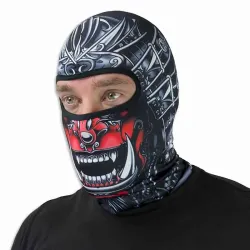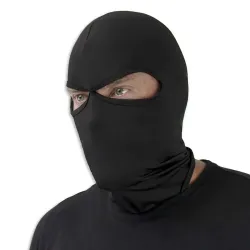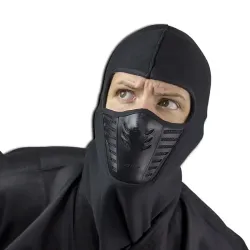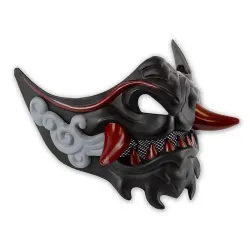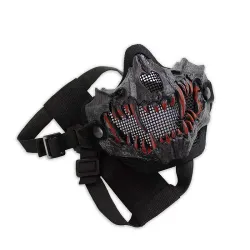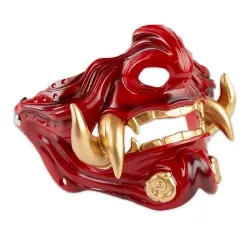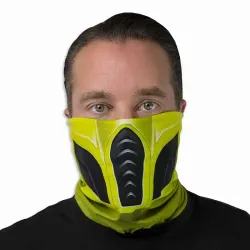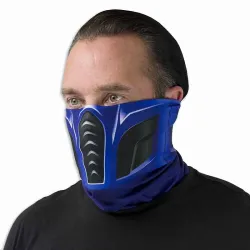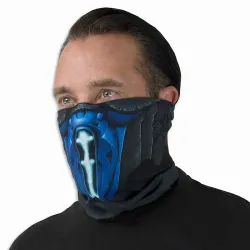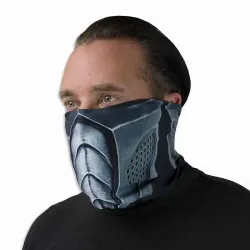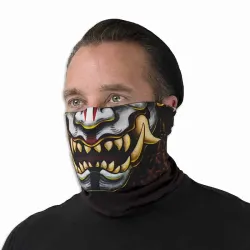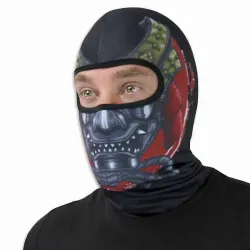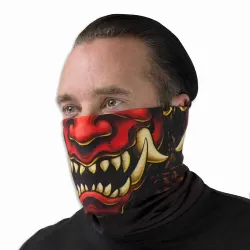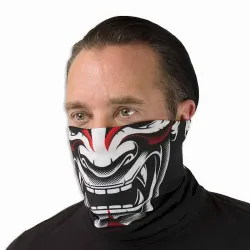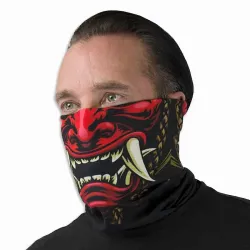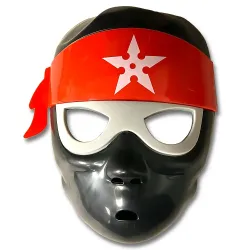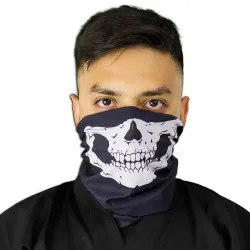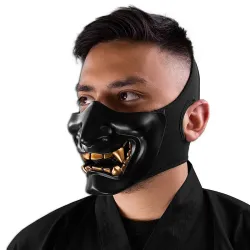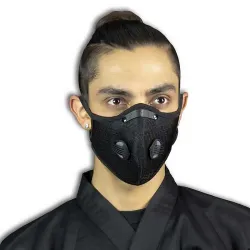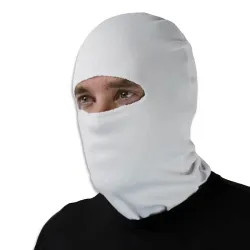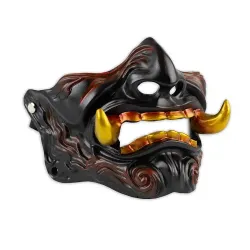Ninja Masks & Hoods
-
$12.95
-
$10.95
-
$16.95
-
$29.95
-
$29.95
-
$29.95
-
$11.95
-
$11.95
-
$11.95
-
$11.95
-
$11.95
-
$12.95
-
$11.95
-
$11.95
-
$11.95
-
$7.95
-
$11.95
-
$29.95
-
$9.95
-
$29.95
Ninja masks, or kawa-mono, have been around for centuries. They're part of the ninja's traditional uniform, which is designed not just for stealth, but also for function. The mask is worn to hide the ninja's identity and protect them from the elements, whether they're scaling a wall or sneaking through dense forests. These masks, often made of cloth, are designed to fit snugly around the face and neck, leaving only the eyes exposed. This makes them incredibly effective at obscuring one's identity while also providing a bit of protection during combat or infiltration missions.
Our selection of ninja masks includes everything from classic black ninja masks to ninja hoods, and even kids ninja masks. If you're looking for something that screams "ninja" but also allows for more flexibility, you can't go wrong with a ninja hood. These hoods provide full head coverage while keeping you comfortable and agile, just like the true warriors of the night. The ninja face masks we carry are perfect for when you want to stay low-key but still maintain that signature ninja style. Some masks are designed to cover only the lower half of the face, giving you an edgy, tactical look while still leaving your eyes free for precision.
The ninja hood is particularly popular if you're aiming for a more traditional look. Ninja hoods were often used by shinobi for their practicality. They offered protection from the elements and helped the ninja blend in with their surroundings, especially in areas where hoods were common clothing. These hoods are just as effective today for cosplay, Halloween costumes, or reenactments. Plus, you'll feel just like the stealthy, mysterious ninja from the old tales.
At KarateMart.com, we carry ninja masks in various styles and colors. The black ninja mask, of course, is a classic; simple, sleek, and perfect for any stealthy mission. But we also offer a variety of colors for those who want to stand out a bit more, whether for cosplay events or just for fun. These masks are made to be comfortable and are crafted from durable materials that'll hold up whether you're jumping into action or just hanging out with your ninja crew.
Kids ninja masks are especially popular, and for good reason. Kids love pretending to be ninjas, and with a mask that fits just right, they can immerse themselves in their ninja role even more. Whether they're running around the backyard pretending to scale a building or sneaking through the house in search of secret treasure, a kids ninja mask makes every adventure more exciting. These masks are sized to fit younger warriors and are made with materials that are both comfortable and safe for hours of play.
The ninja mask is a symbol of the mysterious, shadowy warriors of feudal Japan. These warriors were often hired as spies or assassins, and their ability to blend into the environment was key to their success. The mask was not only used for a disguise, but it was also a tool for intimidation. Imagine slipping into a village under the cover of night, your face hidden, your presence known only by the sound of your footsteps. That's the kind of power a ninja mask gives you; an air of mystery and skill that speaks for itself.
Whether you're gearing up for a ninja-themed event, adding the final touch to your Halloween costume, or simply embracing the ninja lifestyle, we've got the ninja masks you need to complete your look. From the sleek black ninja mask to the versatile ninja face mask, the options are endless. So why not gear up, put on your ninja mask, and start your next adventure? After all, no ninja is complete without their mask.
Did ninjas really wear masks?
The idea of ninjas wearing masks is deeply ingrained in modern pop culture, but the historical reality is a bit more nuanced. To understand whether ninjas truly wore masks, it's important to explore the origins of ninjutsu, the role of the ninja, and how their attire evolved over time.
History of the Ninja
The term "ninja" (or shinobi) refers to individuals who specialized in espionage, stealth, sabotage, and assassination during Japan's feudal era. They were employed by samurai, warlords, and even merchant classes for their skills in infiltration and covert operations. Ninjas were trained in a variety of techniques to help them blend into their surroundings, avoid detection, and achieve their mission goals, often under the cover of darkness.
However, while the idea of the ninja wearing a mask is a modern convention, it does have roots in the practical clothing choices of the time. The ninja's outfit, known as a ninja-yoroi, was designed to be inconspicuous and versatile. It was often dark-colored (black, blue, or dark grey), so that the wearer could blend in with the shadows during nighttime operations.
Masks in Ninja History
Historically, ninja masks weren't as ubiquitous as they are in today's depictions. The ninja's primary focus was practicality, and much of the attire they wore was adapted from common peasant or traveler clothing. These garments were intended to make them blend into everyday life and avoid suspicion.
That being said, some historical records suggest that ninja masks did exist, but they were not necessarily as elaborate or stylized as the ones we see in movies and comics today. The primary function of the mask, when it was used, was to conceal the identity of the ninja. This was important for a couple of reasons:
- Disguise: A ninja's identity had to remain hidden, especially when operating in enemy territory. The mask helped cover the face, ensuring that anyone encountering the ninja would not be able to recognize them later. It was a form of protection, not just for the ninja, but for those they were working for.
- Protection: In some cases, masks may have been used to protect the ninja from environmental elements. In Japan, the landscape could be rugged, and missions could take the ninja through forests, mountains, or even swamps. Masks made from cloth or other materials would help protect the face from dirt, wind, or debris.
- Fear and Intimidation: The image of a masked, faceless figure became a tool of psychological warfare. A ninja, wearing a mask, could invoke fear, as it suggested an otherworldly or ghost-like presence. The facelessness removed any personal identity, which further contributed to the perception of the ninja as mysterious and almost mythical.
The Ninja Mask in Popular Culture
The popularity of the ninja mask as a defining feature of the ninja persona grew significantly in the 20th century, largely thanks to Hollywood films, television shows, and manga comics. The iconic black mask covering the face, often paired with a matching outfit, became a standard look for the "ninja" archetype.
It's also worth noting that the portrayal of ninjas in popular culture doesn't always align with historical practices. Many depictions focus on an almost theatrical portrayal of ninjas, including their masks, throwing stars, and other weapons, which weren't always part of the ninja's toolkit in reality.
Were Ninja Masks Used by All Ninjas?
Not every ninja would have worn a mask, and certainly not in the dramatic way we're familiar with today. The use of masks would have varied depending on the mission, the environment, and the ninja's specific role. For instance:
- Espionage and Surveillance: In operations that involved spying or gathering intelligence, ninja might have used more subtle means to blend in-wearing ordinary clothing or minimal disguises. A mask would not have been necessary if the goal was to remain inconspicuous.
- Assassination and Infiltration: In missions where a ninja needed to strike quickly or enter an enemy stronghold unnoticed, wearing a mask to conceal their identity could have been more common. A ninja's role as an assassin would have necessitated a more stealthy appearance, and covering the face would prevent recognition in case the mission failed.
- Ninja in Large Battles: In battles or large skirmishes, where ninjas were sometimes called in to sow chaos, distract the enemy, or sabotage their supplies, the use of a mask may have been less common. In these cases, they might have blended in with the regular soldiers or used their skills in guerrilla warfare rather than relying on the iconic mask.
Conclusion: The Mask's Symbolic Role
In short, while ninjas did wear masks in some instances, their use was not as widespread or as uniform as modern depictions suggest. The mask was primarily a tool for anonymity, practicality, and intimidation, but it was just one piece of a much larger ninja wardrobe that included dark, inconspicuous clothing. As the image of the ninja evolved through literature, theater, and film, the mask became a more prominent and recognizable feature, adding to the mystique and allure of the ninja legend.
So, while ninjas may not have always worn masks as we imagine them today, the mask has become one of the most enduring symbols of the ninja's legacy. It's a simple, yet powerful representation of the stealth, secrecy, and skill that made these warriors so legendary in history.





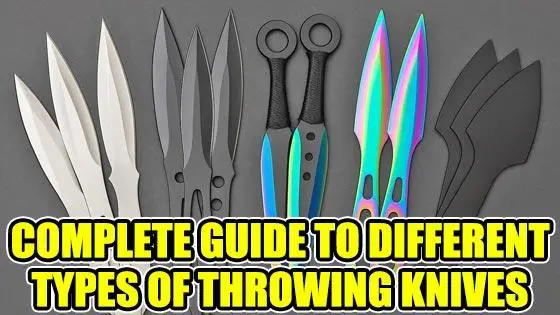
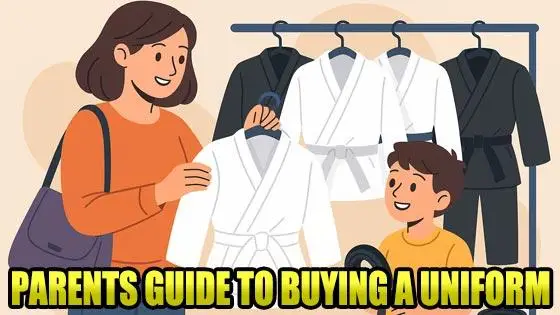

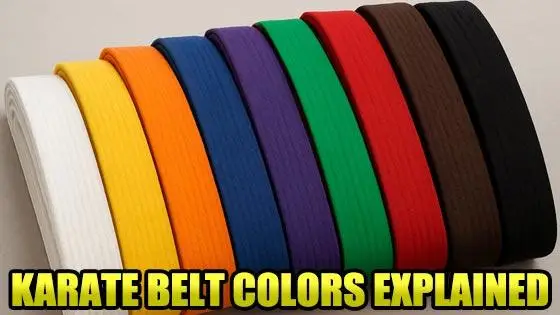
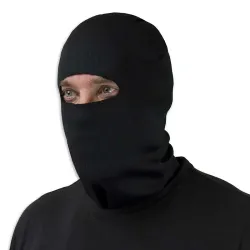
 (1)
(1)